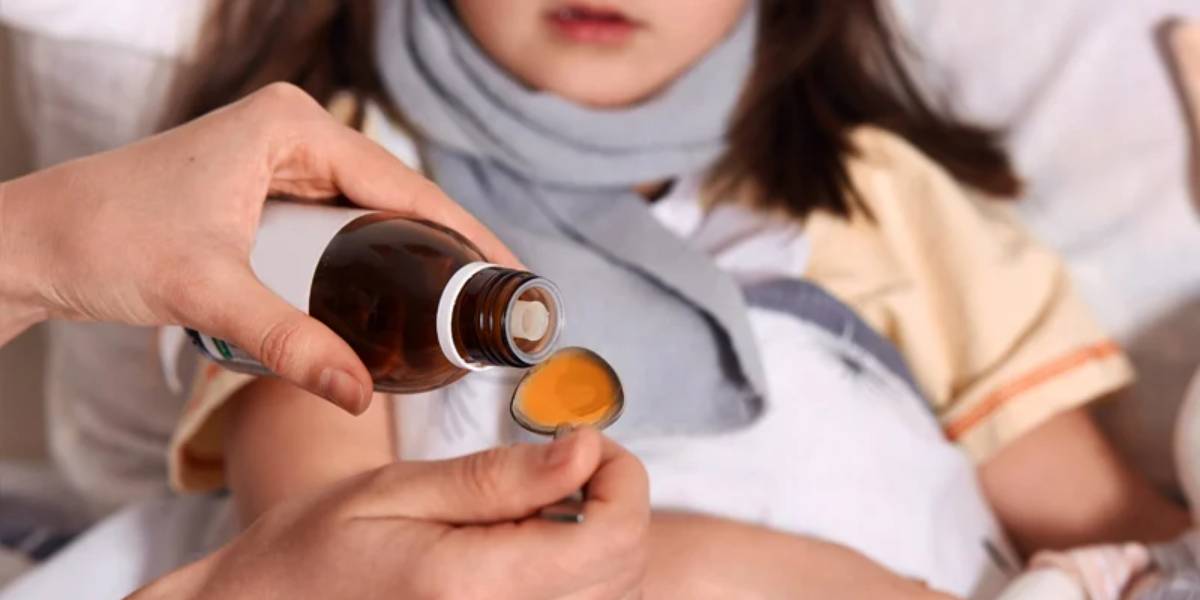The Health Ministry has advised that the drug should not be used in children under four years unless specifically prescribed by a physician.
Published Apr 18, 2025 | 12:27 PM ⚊ Updated Apr 18, 2025 | 12:27 PM

Phenylephrine, due to its action on blood vessels, may cause elevated blood pressure, palpitations, or headaches in some users. In rare cases, allergic reactions or rashes may occur.
Synopsis: The fixed-dose combination that has now been restricted for children under four contains two active ingredients: Chlorpheniramine Maleate and Phenylephrine Hydrochloride, both commonly used in over-the-counter medications to relieve symptoms of the common cold and allergic rhinitis.
Citing safety concerns, the Union Ministry of Health and Family Welfare has restricted the use of a widely available cough syrup in children below four.
In a gazette notification, the government announced that fixed-dose combinations (FDC) of Chlorpheniramine Maleate and Phenylephrine Hydrochloride should not be used in children below four years.
Manufacturers have been directed to clearly display a warning on the label, package insert, and promotional material of the drug indicating its inappropriateness for this age group.
“Whereas the Central Government is satisfied that the use of the drug fixed-dose combination of Chlorpheniramine Maleate + Phenylephrine Hydrochloride is likely to involve risk to children below four years of age, and whereas safer alternatives to the said drug are available… the matter was examined by the Subject Expert Committee appointed by the Central Government,” the notification said.
The committee recommended that all formulations of the said FDC should carry the warning: “This fixed-dose combination shall not be used in children below four years of age.”
This move follows a series of global and domestic reviews raising concerns about the safety and efficacy of certain over-the-counter medications for young children, especially in cases where safer alternatives are readily available.
The fixed-dose combination that has now been restricted for children under four contains two active ingredients: Chlorpheniramine Maleate and Phenylephrine Hydrochloride. Both are commonly used in over-the-counter medications to relieve symptoms of the common cold and allergic rhinitis.
Chlorpheniramine Maleate is an antihistamine. It works by blocking the action of histamine, a chemical released by the body during allergic reactions that causes symptoms such as sneezing, itching, watery eyes, and a runny nose. By acting as an inverse agonist at histamine H1 receptors, the drug helps alleviate these discomforts.
Phenylephrine Hydrochloride, on the other hand, is a nasal decongestant. It relieves congestion by narrowing the blood vessels in the nasal passages, which reduces swelling and makes it easier to breathe.
The combination of the two drugs is often used to treat cold-related symptoms such as nasal congestion, sneezing, and watery eyes, as well as those stemming from allergies.
While generally considered effective, the combination can cause a range of side effects. Chlorpheniramine often leads to drowsiness, dizziness, dry mouth, and occasionally gastrointestinal discomfort such as nausea or constipation. In children, it may also cause restlessness or excitement instead of sedation.
Phenylephrine, due to its action on blood vessels, may cause elevated blood pressure, palpitations, or headaches in some users. In rare cases, allergic reactions or rashes may occur.
Young children are particularly vulnerable to the adverse effects of such medications.
Drowsiness, restlessness, and changes in blood pressure or heart rate can pose serious risks in this age group.
The government’s recent decision follows recommendations from a Subject Expert Committee, which concluded that safer alternatives exist and that the risks outweigh the benefits in children below four.
The Health Ministry has advised that the drug should not be used in children under four years unless specifically prescribed by a physician.
Even in older children and adults, precautions should be taken. Drowsiness is a common side effect, and patients are advised not to drive vehicles or operate heavy machinery after taking the medication. Alcohol consumption can exacerbate dizziness and should be avoided.
The drug should be used with caution in people with underlying conditions such as liver or kidney disease, cardiovascular issues, glaucoma, asthma, prostate enlargement, or diabetes.
It may also interact with several other medications, including monoamine oxidase inhibitors (MAOIs), blood pressure medications, antidepressants, and certain asthma drugs. Pregnant or breastfeeding women are advised to consult a doctor before use.
The decision to restrict the use of the fixed-dose combination of Chlorpheniramine Maleate and Phenylephrine Hydrochloride in children below the age of four stems from recommendations made by both the Subject Expert Committee and the Drugs Technical Advisory Board (DTAB).
According to the Union Ministry of Health and Family Welfare’s gazette notification, the DTAB reviewed the fixed-dose combination and advised that its use in children under four years of age should be prohibited under Section 26A of the Drugs and Cosmetics Act, 1940.
The board also recommended that the manufacture, sale, and distribution of this drug be permitted only with the condition that manufacturers display a warning label stating: “This fixed-dose combination shall not be used in children below four years of age.”
“On the basis of the recommendations of the said Drugs Technical Advisory Board, the Central Government is satisfied that it is necessary and expedient in public interest to regulate by way of restriction the manufacture for sale, sale, and distribution for human use of the said drug in the country,” rhe notification further stated.
Invoking its powers under Section 26A of the Act, the Central Government formally announced the restriction on all formulations of this drug combination, mandating that the warning be prominently included on labels, package inserts, and any promotional literature associated with the product.
(Edited by Majnu Babu).
